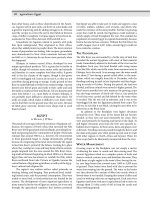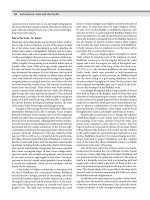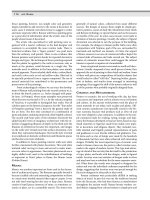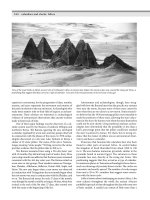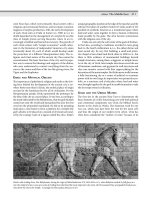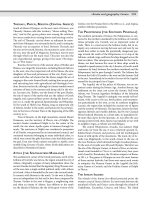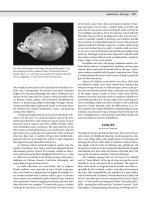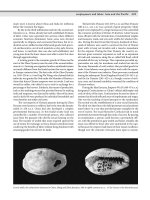Encyclopedia of society and culture in the ancient world ( PDFDrive ) 145
Bạn đang xem bản rút gọn của tài liệu. Xem và tải ngay bản đầy đủ của tài liệu tại đây (45.67 KB, 1 trang )
116
art: Rome
fresco painting, however, was simple color and geometric
shapes, intended to add variety to the rooms it decorated. In
some cases it imitated varicolored stone to suggest a richer
and more expensive effect. Roman wall fresco painting gives
us a great deal of information about the artistic taste of the
people whose houses it decorated.
The artists who specialized in wall painting were organized with a master craft sman as the lead designer and
assistants to accomplish the more routine tasks. There is
historical evidence that a “figure painter” was paid more
than the ordinary wall painter. There is also evidence that
Roman painters used pattern books for repeated decorative
designs and types. The technique of fresco painting required
that the plaster be applied to the walls in sections, only as
much as the painters could decorate in a single day. The
materials used, in addition to the lime plaster, were mainly
natural pigments. These included chalk white, carbon black,
and earth colors such as red and yellow ocher. Blue had to
be specially produced from a copper compound. The use of
natural materials has contributed to the permanence and
preservation of the paintings.
From archaeological evidence we can trace the development of Roman wall painting from the second century b.c.e.
to about the fourth century c.e. Styles changed with popular taste. At Pompeii, where many examples were preserved
when the town was buried in 79 c.e. by the volcanic eruption
of Vesuvius, it is possible to distinguish four styles. Not all
scholars agree on the historical sequence, but the “four styles
of Pompeian painting” form a basis for the general study of
the art form. The first style consisted of a combination of
paint and plaster, imitating stonework, often brightly colored.
The second style kept some of the imitation stonework but
added fanciful views of imaginary architecture with the intention of suggesting illusions of depth. In the third style the
illusions of architecture became less important, and images
on the walls were treated more like surface decoration, even
when they represented landscapes. The fourth style reverted
to an emphasis on fantastic architecture and illusionist spaces
and became even more elaborate.
In addition to fresco painting, interior walls were often
further ornamented with plaster decoration. This work often
imitated relief carving in stone and served to make interiors even richer in appearance. Decorative plasterwork was a
highly skilled craft, used in the embellishment of buildings
as important as Nero’s palace in Rome, the Domus Aurea
(Golden House).
MOSAIC
Mosaic was another important art form used in the decoration of architectural spaces. The Romans especially favored it
because it added color and interesting compositions to floors
in a much more durable material than rugs or carpets. It was
not only hard wearing but also easy to keep clean. Mosaics
consist of small pieces (tesserae) of stone, or sometimes ceramics or glass, set in a cementlike matrix. The stones were
generally of natural colors, collected from many different
sources. The designs of mosaic floors might be simple geometric patterns, scenes of daily life, illustrations from Greek
and Roman mythology, or special themes such as the seasons
or months of the year. In some cases mosaics were made in
imitation of famous paintings. Usually, the subject of figural
decoration was selected to suit the purpose of the building.
For example, the designs in Roman public baths were often
compositions with Neptune, god of the sea, surrounded by
mermaids and mythical sea animals. At Ostia, the seaport
of Rome, mosaics in an area of commercial offices depict the
various kinds of business and trade carried out. The subject
matter of a domestic mosaic floor could suggest the cultural
interest or special occupation of a householder.
Some exceptional mosaics were made as small wall decorations. Usually composed of very small pieces of stone, they
approach the art of painting in their detail and realism. Some
of these wall pieces are compositions of familiar objects that
would today be called “still lifes.” Depicting bottles, glasses,
fruit in baskets, and similar items arranged in interesting
groupings, they suggest the skill of the mosaic makers as well
as of the painters who probably originally designed them.
CERAMICS
AND
METALWORKING
Pottery or ceramics, the art of working with clay, has been
a necessary and important craft in almost every civilization
and culture. In the ancient world pottery took the place of
many materials in use today, such as glass and plastic. Efficient ceramic manufacture was especially crucial to the Roman economy, because vital products such as olive oil and
wine were shipped in clay containers. In addition to the simple containers made for cooking, eating, storage, and shipment, the Romans developed several art forms based on clay.
Small statuettes or figurines made from molds were popular as decorative and religious objects. They included carefully detailed and brightly painted representations of gods
and goddesses or even favorite athletes and gladiators. Useful items such as clay oil lamps were made by the hundreds
of thousands, but they were often enhanced with interesting
designs. Probably the most important type of ceramic ware
made in Roman times was the pottery called Arretine ware,
made in the region of modern Arezzo. This type took advantage of a kind of fine red clay that lent itself to the production
of cups, plates, and bowls with fine designs, made in figured
molds. Arretine ware was imitative of designs made in silver
and may have been a substitute for the more expensive material. Often these clay vessels were stamped to designate the
maker and even the individual craftsman responsible for the
design, suggesting that Arretine ware was special enough for
the artist-designers to take pride in their work.
Roman craftsmen were particularly skillful in making
objects of metal. In part this was one the traditions learned
from the Etruscans, who had been famous as metalworkers
throughout the ancient world. Roman bronze workers created objects ranging from colossal statues to simple pots and
